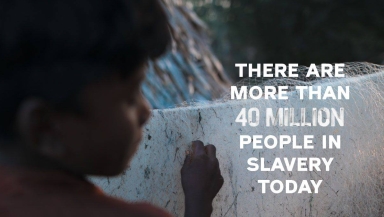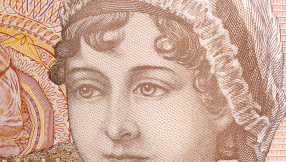
Human trafficking today is a multibillion-dollar global criminal industry that's bigger than ever. On top of this, the Covid-19 pandemic has made some groups even more vulnerable to trafficking and exploitation. As Christians, we need to take urgent action to prevent rises in trafficking and modern slavery, yet many people do not believe that slavery and trafficking still exist – or are believing myths about how it happens. Here are some myth busters to make us all think twice.
Myth 1: Human Trafficking and Slavery don't exist anymore
Reality: While many people think that slavery ended long ago, not so many people know that there are currently 40 million people in slavery - more people than ever before. Shockingly, one in four victims are children. Slavery is real, brutal and it's happening in every country in the world.
This isn't just happening abroad – the Centre for Social Justice recently published a report which suggests that there may be up to 100,000 victims in the UK alone. In fact, human trafficking is one of the top three criminal industries in the world, generating over £100 billion a year.
Recently, IJM provided training to a local church in the Dominican Republic so that they would be able to recognise the signs of human trafficking in their own community. When a teacher noticed that one of their students was no longer living at home, the headteacher (who was a member of the Church congregation) alerted IJM that the 14-year-old girl might be in a dangerous situation. Last month, IJM worked alongside the local police and discovered that the girl has been trafficked into a forced marriage situation with a 58-year-old man. The police were able to bring the girl out of that situation successfully.
When churches join the fight to stop slavery, change happens.
Myth 2: Human Trafficking doesn't impact me
Reality: When you think of human trafficking, you might imagine a man visiting a brothel. What most of us don't realise is that human trafficking affects us all every day – we all use products that are likely to have modern slavery in the supply chains, from clothing to coffee to chocolate to your mobile phone. In fact, a shocking 77% of UK companies have said that they believe there is a likelihood of slavery in their supply chains. It's an uncomfortable thought that the cobalt in your phone battery could have been mined by a child in forced labour in the Democratic Republic of the Congo. Taking action against slavery is up to all of us.
Myth 3: Trafficking is always about forcing women into the sex trade
Reality: While sex trafficking is a major global issue, it's not the only kind of trafficking. An estimated 25 million people are currently in forced labour slavery globally. Forced labour slavery sees children, men and women face danger and abuse in places like factories, farms, quarries, brick kilns and fisheries. People are also trafficked and forced to commit crimes, forced into marriage or to have their organs harvested.
Technology makes new kinds of trafficking possible too – like online sexual exploitation of children, or 'cybersex trafficking'. This vile crime sees sex offenders from all around the world, including the UK, pay to watch livestreamed abuse of young children.
Law enforcement agencies are warning that Covid-19 lockdowns have created the perfect storm for increases in cybersex trafficking. Western sex offenders in places like the UK have been spending more time online, and children in places like the Philippines are locked in with their traffickers.
Myth 4: Victims of trafficking are always kidnapped and physically unable to leave their situation
Reality: While this can happen, more commonly traffickers prey upon vulnerabilities like loss of income, poverty, family medical emergencies and isolation in order to enslave people – all of which are exacerbated by the Covid-19 pandemic. Often, traffickers promise a great job or education opportunity, and build a relationship with the victim so that they trust them, only to abuse that trust later. Many people are trafficked by people they know, including their own families.
While some victims are physically unable to leave, many are kept in that situation through coercion, debt, violence, fear or manipulation rather than being physically locked in. Some traffickers take away the victim's passport or threaten their family.
When Kim (name changed for security reasons) was just 12-years-old, her neighbour promised he would help her and send her to school if she moved in with him. At first, he treated her well, but then a few months after she arrived, he started sexually abusing her in front of a webcam to stream to customers all around the world. Kim described the hold that her neighbour had over her, "it was like he had a total grasp on me and it was so difficult to break away."
Myth 5: Human trafficking only involves women and girls
Reality: While women and girls constitute the majority of detected trafficking victims, almost a third of victims of human trafficking are male. In Thailand, thousands of men are trafficked into the £7 billion fishing industry that puts prawns on the shelves of many UK supermarkets. In fact, a recent study of migrant workers in the Thai fishing industry found that only 13% of workers reported fair labour conditions at sea. Many workers faced low or no wages, long hours, including 13-hour days, violence and - in some cases - they even witnessed murder.
Myth 6: Survivors of trafficking are powerless
Reality: While survivors of trafficking have often experienced extreme trauma that takes years to heal from, many also play a key role in stopping others from experiencing abuse. International Justice Mission, the largest international anti-slavery organisation, has witnessed determined survivors provide vital intelligence for police operations, and courageously testify against traffickers in court to stop exploiters from harming others. Some have even volunteered to accompany police on operations to find and free others.
Pachaiyammal spent years in slavery with her husband, forced to crush rocks in a dangerous quarry. She is now general secretary of an association of 1,500 former forced labourers advocating for change, and she has personally accompanied police on operations to free over 100 people. Others, like Raj (name changed for security reasons), who was trafficked into forced labour in a brick kiln aged just 7 years old, have trained to become social workers or lawyers to help others access healing and justice.
Myth 7: The problem is too huge — there's nothing I can do
Reality: The scale of the slavery today can seem overwhelming. Slavery is bigger than ever, but it's also more stoppable than ever: slavery is illegal almost everywhere which means that when global governments, law enforcement and businesses choose to act, traffickers can be held to account and exploitation can end.
With increases in vulnerability as result of the pandemic, it's more urgent than ever that action is taken to stop ruthless traffickers preying on people's desperation. We all need to recognise that this is a global issue that each of us are connected to and that each one of us has a role in ending. From using your voice to raise awareness and advocate for change, to praying or donating to anti-slavery organisations. Will you choose to take small steps towards a future where all are free?
Find out more about International Justice Mission at www.ijmuk.org













